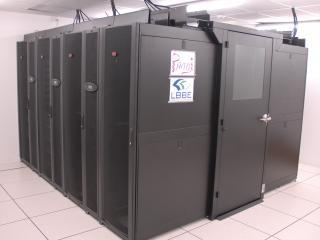Computing services
Members
Ingénieur d'études
CNRS
Tel: 04 72 44 81 42

Ingénieur d'études
CNRS
Tel: 33 04 72 43 11 68

Ingénieur d'études
CNRS
Tel: 04 72 43 35 82

Technicien
UCBL
Tel: 33 04 72 43 29 04

Ingénieur d'études
CNRS
Tel: 33 04 72 43 29 04

Ingénieure de recherche
UCBL
Tel: 33 04 72 44 85 98

Ingénieur de recherche
CNRS
Tel: 33 06 82 87 93 59

Ingénieur de recherche
CNRS
Tel: 33 04 26 23 44 70
info@listes-lbbe.univ-lyon1.fr
The "Pôle informatique" (hereafter called "PI") is constituted of 8 engineers (1T, 4IE, 3IR). Our activities are distributed among three main directions: computing and storage infrastructure management (shared resources, and invidual equipment), software and service development and data analysis in molecular biology and ecology.
Infrastructures managment
- Microcomputing: the PI is in charge of managing the laboratory's microcomputer equipment, from choosing the most appropriate solution in consultation with the future user to managing maintenance, including installation and configuration of the equipment.
- Laboratory Information System: the PI provides laboratory and community members with a number of services, including several web servers (apache), numerous database servers (relational or indexed) and several collaborative tools (Git, Redmine, Seafile...). These services are hosted on largely virtualized machines.

- Compute and storage: since 2009, the PI manages a computing cluster with almost 1200 avalaible computing cores. The cluster is linked to a 600 TB high performing distributed storage system under BeeGFS and an object mode storage based on iRods (~400 useful TB).
- Cloud and containerization: cloud-girofle (224 vcpu and 120 To), the local cloud operated by the PI since 2017, is part of the Biosphere cloud federation from the French Institute of Bioinformatics (IFB). We are starting to converge our virtualization infrastructure towards containerization technologies (docker, singularity).
- User support: the PI provides user support for all the resources and tools available to the laboratory's members. It trains and supports users in their use of shared resources through trainingsessions, information and monitoring meetings and mailing lists.
Software and methodological development
Members of the PI are involved in numerous software development projects in collaboration with the lab researchers, covering a large range of programming languages (R, Python, C++, OCaml, Javascript, SQL, shell). It goes from optimized parallel numerical codes to web services and dedicated databases (SQL or no-SQL). A peculiar effort is also performed to share the best practices of modern software development and make these software codes reproducible and available following the standards and requirements of the community.
Data analysis
Members of the PI are in the front line facing the data avalanche (and the data diversity) of this decade.
A large part of our activity is related to the quantity of data coming from sequencing technologies. The PI develops and proposes pipelines for genomic data assembly and annotation, RNA-seq and RAD-seq data analysis. More recently, computer image processing has become an important issue for future ecological studies performed in the lab in the Evolutionary Ecology.
Animation, training and scientific expertise
Our group has set up a series of dedicated workshops to improve internal skills in software engineering, distributed computing, programming and data analysis, which complements more formal teaching sessions. Members of the group are also involved in training activities in universities (UCBL1) and CNRS (Formation permanente).
In their respective fields, members of the PI actively monitor technological developments and participate in major events such as JOBIM (bioinfo), the JRES (system administration), the JDEV (development), the Aramis days (system and network administration and software development) and the 'Rencontres R' (programmation). The PI is also involved in dedicated networks and/or projects of national scope such as the LyonCalcul group, the RLyon group and the IFB-NNCR and IFB-Core projects.
We works in close cooperation with the bioinformatics platform PRABI (Pôle Rhône-Alpes de BioInformatique), notably for the management of the computing and storage infrastructure, the diffusion of our lab's software production, the organization of teaching sessions and for sharing expertise in genomic/transcriptomic data analysis.
Poster
Publications
Display of 1 to 30 publications on 170 in total
Cluefish: mining the dark matter of transcriptional data series with over-representation analysis enhanced by aggregated biological prior knowledge
NAR Genomics and Bioinformatics . 7 ( 3 ) : lqaf103
Journal article
see the publicationExploring transcriptomic data with over-representation analysis enhanced by aggregated biological prior knowledge
35th Society of Environmental Toxicology and Chemistry (SETAC 2025) .
Conference paper
see the publicationWindi App, an R Shiny Tool to Rapidly Assess the Risk of Culicoides Wind Dispersal
13. International Congress for Veterinary Virology Including an EPIZONE Session .
Poster
see the publicationthirdkind Drawing reconciled phylogenetic trees allowing 1, 2 or 3 reconciliation levels
Software
see the publicationComparative transcriptomics in serial organs uncovers early and pan-organ developmental changes associated with organ-specific morphological adaptation
Nature Communications . 16 ( 1 ) : 768
Journal article
see the publicationThe Silene latifolia genome and its giant Y chromosome
Science . 387 ( 6734 ) : 630-636
Journal article
see the publicationFunctional analysis of interactions between bed bugs and their symbionts Wolbachia and BEV-like
International congress of Ecology and Evolution (SFE2) .
Conference paper
see the publicationPhyloformer: Fast, accurate and versatile phylogenetic reconstruction with deep neural networks
Preprint
see the publicationfitdistrplus: Help to Fit of a Parametric Distribution to Non-Censored or Censored Data
Software
see the publicationHaemolysis overestimates plasma oxidative stress biomarkers in free-ranging roe deer
Comparative Biochemistry and Physiology - Part A: Molecular and Integrative Physiology . 298 : 111750
Journal article
see the publicationade4: Analysis of Ecological Data: Exploratory and Euclidean Methods in Environmental Sciences
Software
see the publicationExtraire automatiquement des informations de décisions des juges aux affaires familiales ?
Justice et numérique. Quels (r)apports ? . 1
Book chapter
see the publicationDynamics of endosymbionts in bed bugs during development
Groupe Régional de Recherche en Microbiologie des Interactions (G-RREMI) .
Poster
see the publicationFunctional analysis of interactions between bed bugs and their nutritional symbiont Wolbachia
Rencontres du Réseau Ecologie des Interactions Durables 2023 .
Poster
see the publicationFunctional analysis of interactions between bed bugs and their nutritional symbiont Wolbachia
Journée scientifique enjeu « santé globale et bio‐ingénierie » de l'INSA Lyon .
Poster
see the publicationGenomic changes during the evolution of the Coxiella genus along the parasitism-mutualism continuum
Peer Community Journal . 3 : e41
Journal article
see the publicationThe for gene as one of the drivers of foraging variations in a parasitic wasp
Molecular Ecology . 32 ( 7 ) : 1760-1776
DOI: 10.1111/mec.16834
Journal article
see the publicationPopulation genomics of Corsican wildcats: Paving the way toward a new subspecies within the Felis silvestris spp. complex?
Molecular Ecology . 32 ( 8 ) : 1908-1924
DOI: 10.1111/mec.16856
Journal article
see the publicationEvolution of sex-biased gene expression during transitions to separate sexes in the Silene genus
Preprint
see the publicationEvaluation of Methods to Detect Shifts in Directional Selection at the Genome Scale
Molecular Biology and Evolution . 40 ( 2 )
Journal article
see the publicationThe DeepFaune initiative: a collaborative effort towards the automatic identification of European fauna in camera trap images
European Journal of Wildlife Research . 69 ( 6 ) : 113
Journal article
see the publicationDRomics, a workflow to exploit dose-response omics data in ecotoxicology
Peer Community Journal . 3 : e90
Journal article
see the publication